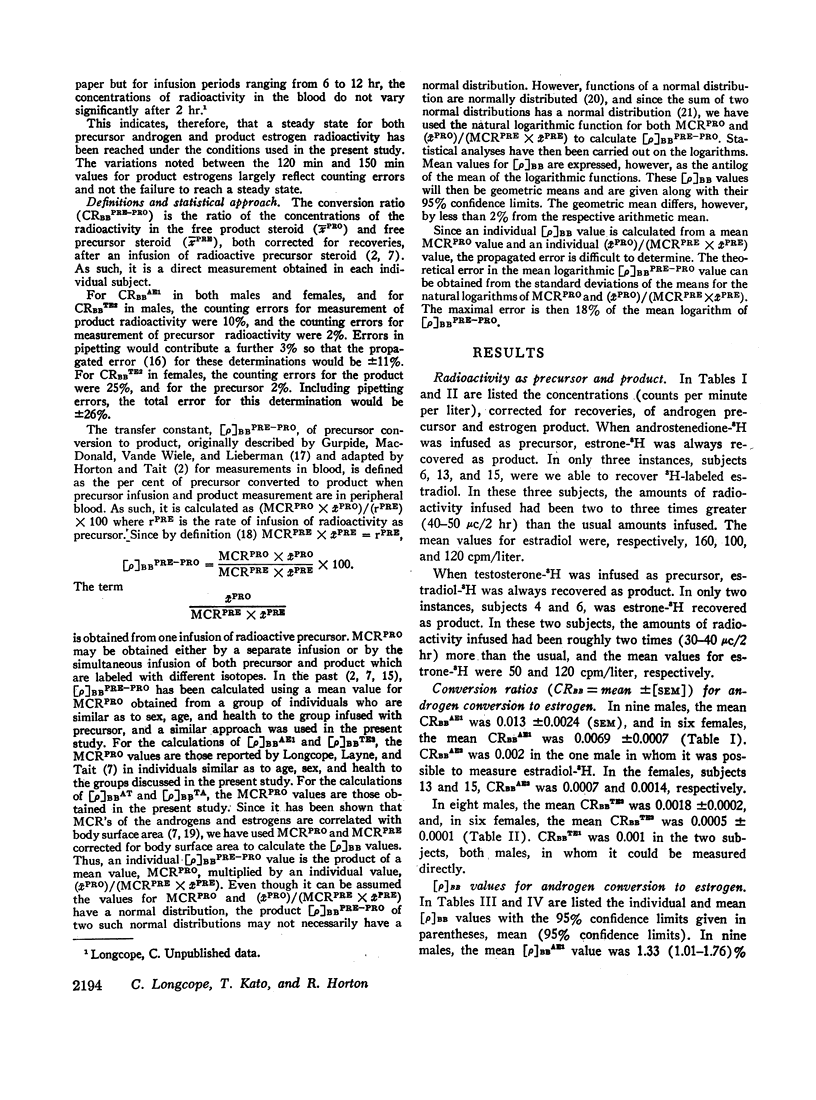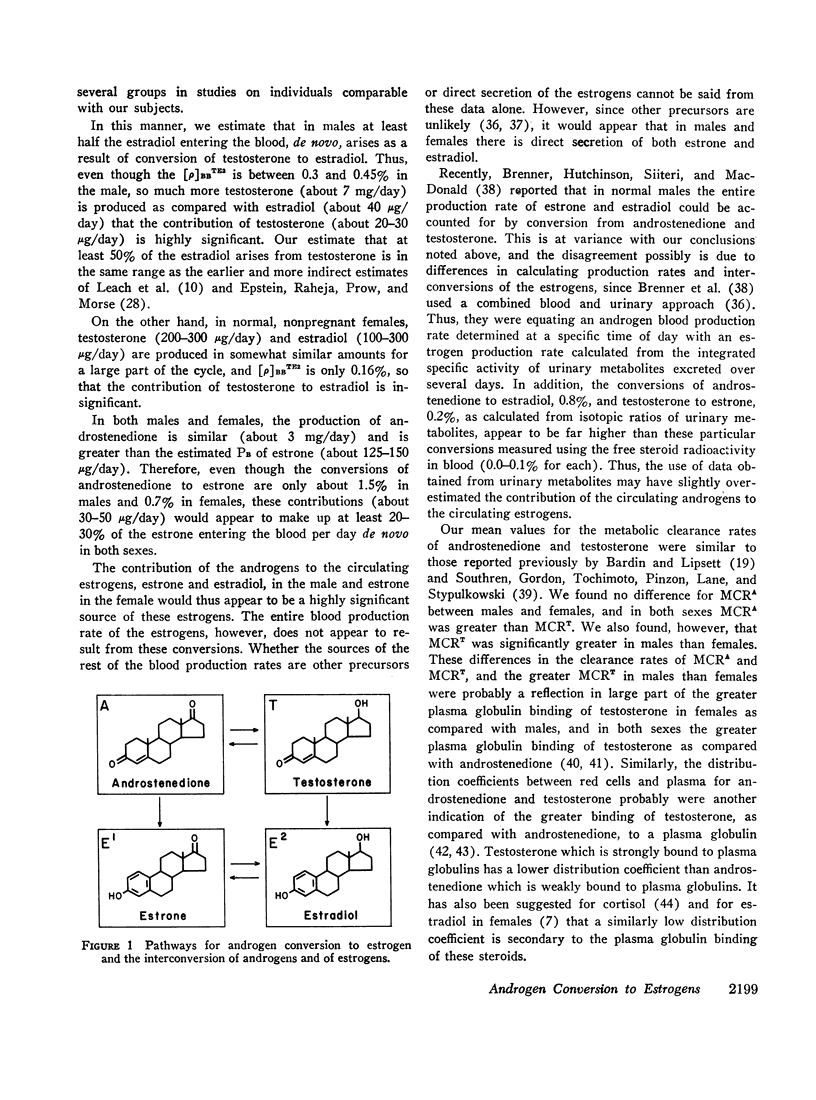Abstract
Continuous infusions of Δ4-androstenedione-7-3H and testosterone-7-3H have been used to demonstrate that these androgens are converted to estrone and 17β-estradiol, and contribute to the circulating blood levels of these estrogens in normal males and females. The conversion ratio (ratio of concentrations of radioactivity of free product steroid [χ-PRO] and free precursor steroid [χ-PRE], both corrected for recoveries, after an infusion of radioactive precursor steroid) for androstenedione (precursor) to estrone (product) is 0.013 in males and 0.007 in females, and the conversion ratio for testosterone (precursor) to estradiol (product) is 0.0018 in males and 0.005 in females. The transfer constant, [ρ]BBAE1, for androstenedione conversion to estrone ([ρ]BBAE1 = per cent of infused androstenedione, precursor, converted to estrone, product, when infusion and measurement are both in blood) is 1.35% in males and 0.74% in females, and the transfer constant, [ρ]BBTE2, for testosterone conversion to estradiol is 0.39% in males and 0.15% in females.
Whether measured as conversion ratio or transfer constant, the peripheral aromatization of androstenedione takes place to a greater degree than that of testosterone, and, for the respective androgens, both the conversion ratio and [ρ]BB value are greater in males than females.
For the androgen interconversions, [ρ]BBAT is 4.5% in males and 2.2% in females; [ρ]BBTA is 8.2% in males and 12.0% in females.
Studies on the distribution coefficients (effective concentration in red cells/plasma) for precursor radioactivity were also made. In both males and females the distribution coefficient for androstenedione is 0.16-0.17 while that of testosterone is 0.01-0.03.
Full text
PDF










Selected References
These references are in PubMed. This may not be the complete list of references from this article.
- BEER C. T., GALLAGHER T. F. Excretion of estrogen metabolites by humans. I. The fate of small doses of estrone and estradiol-17beta. J Biol Chem. 1955 May;214(1):335–349. [PubMed] [Google Scholar]
- BOLTE E., MANCUSO S., ERIKSSON G., WIQVIST N., DICZFALUSY E. STUDIES ON THE AROMATISATION OF NEUTRAL STEROIDS IN PREGNANT WOMEN. I. AROMATISATION OF C-19 STEROIDS BY PLACENTAS PERFUSED IN SITU. Acta Endocrinol (Copenh) 1964 Apr;45:535–559. doi: 10.1530/acta.0.0450535. [DOI] [PubMed] [Google Scholar]
- BRAUN-CANTILO J. A., LA ROCHE G., NOVITSKY M., LAWRENCE J. H. Conversion of testosterone to estrogens in humans. Acta Isot (Padova) 1962 Jun 30;1:351–376. [PubMed] [Google Scholar]
- BREUER H. [Comparative studies on aromatic neutral steroids in man]. Acta Endocrinol (Copenh) 1962 May;40:111–122. [PubMed] [Google Scholar]
- Baird D. T. A method for the measurement of estrone and estradiol-17-beta in peripheral human blood and other biological fluids using 35S pipsyl chloride. J Clin Endocrinol Metab. 1968 Feb;28(2):244–258. doi: 10.1210/jcem-28-2-244. [DOI] [PubMed] [Google Scholar]
- Baird D. T., Horton R., Longcope C., Tait J. F. Steroid dynamics under steady-state conditions. Recent Prog Horm Res. 1969;25:611–664. doi: 10.1016/b978-0-12-571125-8.50017-x. [DOI] [PubMed] [Google Scholar]
- Baird D., Horton R., Longcope C., Tait J. F. Steroid prehormones. Perspect Biol Med. 1968 Spring;11(3):384–421. doi: 10.1353/pbm.1968.0053. [DOI] [PubMed] [Google Scholar]
- Bardin C. W., Lipsett M. B. Testosterone and androstenedione blood production rates in normal women and women with idiopathic hirsutism or polycystic ovaries. J Clin Invest. 1967 May;46(5):891–902. doi: 10.1172/JCI105588. [DOI] [PMC free article] [PubMed] [Google Scholar]
- Epstein B. J., Raheja M. C., Frow E., Morse W. I. Estrogen synthesis in normal and hypogonadal men. Quantitative studies on the precursor role of testosterone. Can J Biochem. 1966 Jun;44(6):971–977. doi: 10.1139/o66-113. [DOI] [PubMed] [Google Scholar]
- FARESE R. V., PLAGER J. E. The in vitro red blood cell uptake of C-14-cortisol; studies of plasma protein binding of cortisol in normal and abnormal states. J Clin Invest. 1962 Jan;41:53–60. doi: 10.1172/JCI104466. [DOI] [PMC free article] [PubMed] [Google Scholar]
- FISHMAN J., BRADLOW H. L., GALLAGHER T. F. Oxidative metabolism of estradiol. J Biol Chem. 1960 Nov;235:3104–3107. [PubMed] [Google Scholar]
- FLOOD C., LAYNE D. S., RAMCHARAN S., ROSSIPAL E., TAIT J. F., TAIT S. A. An investigation of the urinary metabolites and secretion rates of aldosterone and cortisol in man and a description of methods for their measurement. Acta Endocrinol (Copenh) 1961 Feb;36:237–264. doi: 10.1530/acta.0.0360237. [DOI] [PubMed] [Google Scholar]
- FRENCH F. S., BAGGETT B., VANWYK J. J., TALBERT L. M., HUBBARD W. R., JOHNSTON F. R., WEAVER R. P., FORCHIELLI E., RAO G. S., SARDA I. R. TESTICULAR FEMINIZATION: CLINICAL, MORPHOLOGICAL AND BIOCHEMICAL STUDIES. J Clin Endocrinol Metab. 1965 May;25:661–677. doi: 10.1210/jcem-25-5-661. [DOI] [PubMed] [Google Scholar]
- Forest M. G., Rivarola M. A., Migeon C. J. Percentage binding of testosterone, androstenedione and dehydroisoandrosterone in human plasma. Steroids. 1968 Sep;12(3):323–343. doi: 10.1016/0039-128x(68)90025-1. [DOI] [PubMed] [Google Scholar]
- Frieden E. H., Patkin J. K., Mills M. Effects of follicle stimulating hormone (FSH) upon steroid aromatization in vitro. Proc Soc Exp Biol Med. 1968 Nov;129(2):606–609. doi: 10.3181/00379727-129-33380. [DOI] [PubMed] [Google Scholar]
- GIVNER M. L., BAULD W. S., HALE T. R., VAG I. K., NILSEN M. The effect of corticotropin, chorionic gondotropin and testosterone propionate on urinary estradiol-17 beta, estrone and estriol of human subjects with previous myocardial infarction. J Clin Endocrinol Metab. 1960 May;20:665–674. doi: 10.1210/jcem-20-5-665. [DOI] [PubMed] [Google Scholar]
- Gordon G. G., Southren A. L., Tochimoto S., Rand J. J., Olivo J. Effect of hyperthyroidism and hypothyroidism on the metabolism of testosterone and androstenedione in man. J Clin Endocrinol Metab. 1969 Feb;29(2):164–170. doi: 10.1210/jcem-29-2-164. [DOI] [PubMed] [Google Scholar]
- Horton R., Tait J. F. Androstenedione production and interconversion rates measured in peripheral blood and studies on the possible site of its conversion to testosterone. J Clin Invest. 1966 Mar;45(3):301–313. doi: 10.1172/JCI105344. [DOI] [PMC free article] [PubMed] [Google Scholar]
- KORENMAN S. G., LIPSETT M. B. IS TESTOSTERONE GLUCURONOSIDE UNIQUELY DERIVED FROM PLASMA TESTOSTERONE? J Clin Invest. 1964 Nov;43:2125–2131. doi: 10.1172/JCI105086. [DOI] [PMC free article] [PubMed] [Google Scholar]
- Kato T., Horton R. Studies of testosterone binding globulin. J Clin Endocrinol Metab. 1968 Aug;28(8):1160–1168. doi: 10.1210/jcem-28-8-1160. [DOI] [PubMed] [Google Scholar]
- LEACH R. B., MADDOCK W. O., PAULSEN C. A., TOKUYAMA I. Clinical studies of testicular hormone production. Recent Prog Horm Res. 1956;12:377-98; discussion, 398-403. [PubMed] [Google Scholar]
- Longcope C., Layne D. S., Tait J. F. Metabolic clearance rates and interconversions of estrone and 17beta-estradiol in normal males and females. J Clin Invest. 1968 Jan;47(1):93–106. doi: 10.1172/JCI105718. [DOI] [PMC free article] [PubMed] [Google Scholar]
- MacDonald P. C., Rombaut R. P., Siiteri P. K. Plasma precursors of estrogen. I. Extent of conversion of plasma delta-4-androstenedione to estrone in normal males and nonpregnant normal, castrate and adrenalectomized females. J Clin Endocrinol Metab. 1967 Aug;27(8):1103–1111. doi: 10.1210/jcem-27-8-1103. [DOI] [PubMed] [Google Scholar]
- Mancuso S., Benagiano G., Dell'Acqua S., Shapiro M., Wiqvist N., Diczfalusy E. Studies on the metabolism of C-19 steroids in the human foeto-placental unit. 4. Aromatisation and hydroxylation products formed by previable foetuses perfused withandrostenedione and testosterone. Acta Endocrinol (Copenh) 1968 Feb;57(2):208–227. doi: 10.1530/acta.0.0570208. [DOI] [PubMed] [Google Scholar]
- Pearlman W. H., Crépy O. Steroid-protein interaction with particular reference to testosterone binding by human serum. J Biol Chem. 1967 Jan 25;242(2):182–189. [PubMed] [Google Scholar]
- Rosner W., Deakins S. M. Testosterone-binding globulins in human plasma: studies on sex distribution and specificity. J Clin Invest. 1968 Sep;47(9):2109–2116. doi: 10.1172/JCI105896. [DOI] [PMC free article] [PubMed] [Google Scholar]
- Saez J. M., Migeon C. J. Problems related to the determination of the secretion and interconversion of androgens by "urinary" methods. Steroids. 1967 Oct;10(4):441–456. doi: 10.1016/0039-128x(67)90121-3. [DOI] [PubMed] [Google Scholar]
- Southren A. L., Gordon G. G., Tochimoto S., Pinzon G., Lane D. R., Stypulkowski W. Mean plasma concentration, metabolic clearance and basal plasma production rates of testosterone in normal young men and women using a constant infusion procedure: effect of time of day and plasma concentration on the metabolic clearance rate of testosterone. J Clin Endocrinol Metab. 1967 May;27(5):686–694. doi: 10.1210/jcem-27-5-686. [DOI] [PubMed] [Google Scholar]
- TAIT J. F., TAIT S. A., LITTLE B., LAUMAS K. R. The disappearance of 7-H-3-d-aldosterone in the plasma of normal subjects. J Clin Invest. 1961 Jan;40:72–80. doi: 10.1172/JCI104239. [DOI] [PMC free article] [PubMed] [Google Scholar]
- VANDEWIELE R. L., MACDONALD P. C., GURPIDE E., LIEBERMAN S. STUDIES ON THE SECRETION AND INTERCONVERSION OF THE ANDROGENS. Recent Prog Horm Res. 1963;19:275–310. [PubMed] [Google Scholar]
- WEST C. D., DAMAST B. L., SARRO S. D., PEARSON O. H. Conversion of testosterone to estrogens in castrated, adrenalectomized human females. J Biol Chem. 1956 Jan;218(1):409–418. [PubMed] [Google Scholar]


